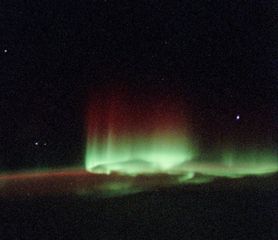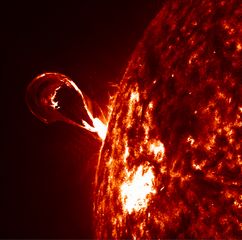Space Radiation
Space Radiation
Space Radiation
Everywhere in space there is plasma and high-energetic radiation. They originate from the Sun, other galactic or cosmic sources, or ionizations of atoms and molecules in the upper Earth atmosphere. The main components are: electrons, protons, and heavy ions. Caused by Earth's magnetic field, there are captured electrons and protons around the Earth, the so-called van Allen radiation belts. The Sun emits continuous solar winds and occasionally erupts releasing energetic protons. The energies of electrons can be up to some MeV, those of protons up to 100 MeV, and the energies of heavy ions can be up to some GeV. This radiation affects astronauts as well as electronics and other sensitive components of satellites (e.g. solar cells).
Up to energies of about 50 eV one speaks of plasma. Plasma can cause electrostatic charging of the surface of satellites. This can potentially cause discharges which can damage sensitive equipment. Eruptions of plasma and radiation from the Sun can affect the Earth as well. E.g., they create the auroras or influence communication and navigation by interaction with the ionosphere. By analyses of data from radiation monitors and observations of the Sun, attempts are made to predict eruptions and periods with particular intensive radiation.


Rosetta - SREM
The SREM is a standard radiation and environment monitor. It was developed to characterize the spectrum of high-energy particles from 10 MeV up to some 100 MeV in space. The SREM was installed on different satellites, like INTEGRAL, Proba-1, or Rosetta. Hence, the monitor offers data from the interplanetary solar environment of protons, the radiation belt, and the galactic cosmic radiation.
In the field of radiation several activities are performed at the University of Oldenburg in cooperation with the ESA. For example Monte-Carlo simulations were carried out, determining the response function of the SREM. Radiation data from detectors on various spacecraft near earth and in interplanetary space are analysed. More data from real radiation monitors in space are available and await investigations.
If you are interested in writing a Bachelor’s or Master’s thesis connected to this topic please contact Sascha Lüdeke or Vanessa Wyrwoll.
